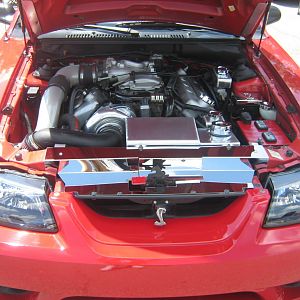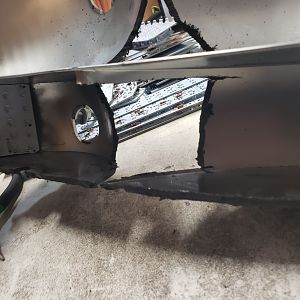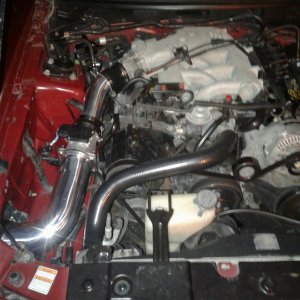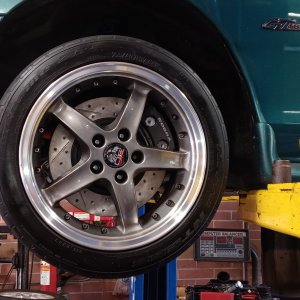Shifty Powers
Well-Known Member
This is a very simple process for those trying to decipher the numbers and letters on your tires. Most importantly, your overall tire height. This is helpful if you want to upgrade your rim size and keep the same overall dimensions or for calculation of gear needs.
For this example, we're going to use the sample tire size P215/50R17 91V
The first character, usually P, LT, or T stand for the type of vehicle this tire has been engineered for.
P for passenger car
LT for light truck
T for temporary
etc, etc
If there is no indication of a character, then the tire has been manufacturer in accordance with European Standards
Common tire sizes are broken down into three parts
First Number: Tread Width, usually in millimeters (215)
Second Number: Sidewall Ratio of tread width to sidewall height (50)
In this example, the side wall is 50% of the tread width
Sidewall height = Tread width * Sidewall Ratio
Sidewall height = 215mm * 50%
(when multiplying a percentage, use a decimal to signify the percent of the value we are multiplying. In our case, use .50)
Sidewall height = 107.5mm
To convert this number to inches, multiply the Sidewall height by .03937
107.5mm * .03937 = 4.23in
Third Number: Wheel Diameter (R17) The R in the third number stands for a Radial Tire.
Now, In order to determine total tire height, Multiple the sidewall height by 2 (to account for the top and bottom sidewall) and then add the rim diameter4.23in + 4.23in + 17in = 25.46in
The next part I copied from another site as it explains it best
"The second part of the number is the service description. Written here as 91V, this tells us two things.
First, 91 indicates the tire's load index. This is an assigned numerical value used to compare the relative load-carrying capabilities of any given tire. In general, higher numbers indicate greater load carrying capacities.
A standard conversion table is used to decode the maximum load for any given tire. The scale starts at 50 (418.8 pounds) and goes up in single increments to 124 (3,527.5 pounds) though most modern passenger cars and light trucks fall somewhere between 70 and 110. In our example, this tire can be loaded with up to 1,356 pounds.
Second, and just as important, is the speed rating for this tire. This is also an assigned value system. In this case, V indicates this tire is approved for speeds up to 149 mph."
For this example, we're going to use the sample tire size P215/50R17 91V
The first character, usually P, LT, or T stand for the type of vehicle this tire has been engineered for.
P for passenger car
LT for light truck
T for temporary
etc, etc
If there is no indication of a character, then the tire has been manufacturer in accordance with European Standards
Common tire sizes are broken down into three parts
First Number: Tread Width, usually in millimeters (215)
Second Number: Sidewall Ratio of tread width to sidewall height (50)
In this example, the side wall is 50% of the tread width
Sidewall height = Tread width * Sidewall Ratio
Sidewall height = 215mm * 50%
(when multiplying a percentage, use a decimal to signify the percent of the value we are multiplying. In our case, use .50)
Sidewall height = 107.5mm
To convert this number to inches, multiply the Sidewall height by .03937
107.5mm * .03937 = 4.23in
Third Number: Wheel Diameter (R17) The R in the third number stands for a Radial Tire.
Now, In order to determine total tire height, Multiple the sidewall height by 2 (to account for the top and bottom sidewall) and then add the rim diameter4.23in + 4.23in + 17in = 25.46in
The next part I copied from another site as it explains it best
"The second part of the number is the service description. Written here as 91V, this tells us two things.
First, 91 indicates the tire's load index. This is an assigned numerical value used to compare the relative load-carrying capabilities of any given tire. In general, higher numbers indicate greater load carrying capacities.
A standard conversion table is used to decode the maximum load for any given tire. The scale starts at 50 (418.8 pounds) and goes up in single increments to 124 (3,527.5 pounds) though most modern passenger cars and light trucks fall somewhere between 70 and 110. In our example, this tire can be loaded with up to 1,356 pounds.
Second, and just as important, is the speed rating for this tire. This is also an assigned value system. In this case, V indicates this tire is approved for speeds up to 149 mph."
| Rating | M | N | P | Q | R | S | T | U | H | V | W | Y | Z |
| Max. MPH | 81 | 87 | 93 | 99 | 106 | 112 | 118 | 124 | 130 | 149 | 168 | 186 | >149 |
| Max. KM/H | 130 | 140 | 150 | 160 | 170 | 180 | 190 | 200 | 210 | 240 | 270 | 300 | >240 |









